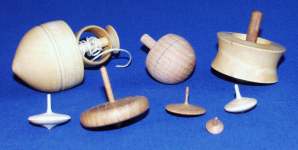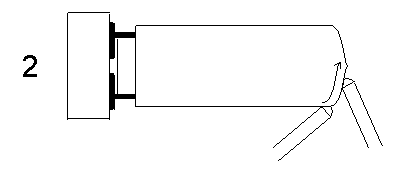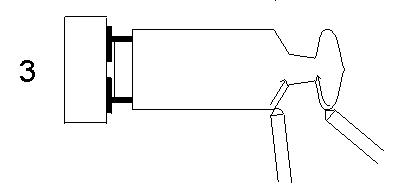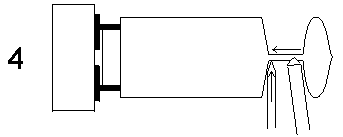| Main page | Læs denne side på dansk |

|
 1. A blank is mounted between centres. Most types of wood are suited but it should be without knots and other defects. In some scroll chucks you can mount a square blank and if you have such a chuck this is the easiest. If you don't have a scroll chuck, you may mount the wood on a faceplate, screw chuck, jam chuck or in the spindle morse taper.
1. A blank is mounted between centres. Most types of wood are suited but it should be without knots and other defects. In some scroll chucks you can mount a square blank and if you have such a chuck this is the easiest. If you don't have a scroll chuck, you may mount the wood on a faceplate, screw chuck, jam chuck or in the spindle morse taper.
If you aren't sure how long a blank your chuck can hold, use a shorter one that in the illustration. The one shown can give three tops. The blank is turned round, fastest with a roughing gouge, but a bowl gouge, spindle gouge or skew can also be used. If turned between centres, turn a tenon to fit the scroll chuck or the morse taper. I use a 10 mm bowl gouge for all the project but you may use a skew or parting tool for turning the tenon or for more of the project. The tenon is shown in the headstock end but you can make it in the other end if you prefer. |
 2. The wood is now mounted in the chuck (or taper or jam chuck or...) and turned true. Then the lower part of the top is turned. The important part is the point it spins on. The tool is placed with the bevel on the long side near the end and the corner is cut away bit for bit. The bevel has to be kept parallel to the surface so the handle has to be moved up to 90° during the cut.
2. The wood is now mounted in the chuck (or taper or jam chuck or...) and turned true. Then the lower part of the top is turned. The important part is the point it spins on. The tool is placed with the bevel on the long side near the end and the corner is cut away bit for bit. The bevel has to be kept parallel to the surface so the handle has to be moved up to 90° during the cut.
The lower surface is now sanded. |
 3. The upper side is turned in the same way as the underside - but, of course, in the opposite direction. It will be necessary to remove some wood to the left to make room for the tool.
3. The upper side is turned in the same way as the underside - but, of course, in the opposite direction. It will be necessary to remove some wood to the left to make room for the tool.
The upper side is sanded. |
 4. Now comes the most difficult part, the narrow handle of the top. In the beginning, you can turn with the same technique as for the underside of the top, but at a point, you can't keep the bevel in contact with the wood with this technique. Here are more possibilities. I rotate the bowl gouge so that the bevel gets into contact with the wood and the tool cuts with one of the wings/outer parts of the cuting edge as shown in the illustration. You may also change to a small spindle gouge.
4. Now comes the most difficult part, the narrow handle of the top. In the beginning, you can turn with the same technique as for the underside of the top, but at a point, you can't keep the bevel in contact with the wood with this technique. Here are more possibilities. I rotate the bowl gouge so that the bevel gets into contact with the wood and the tool cuts with one of the wings/outer parts of the cuting edge as shown in the illustration. You may also change to a small spindle gouge.
The handle is sanded when it has been turned. Finally, the top is detached by turning a v-shaped notch through the handle with a skew or a spindle gouge. You may also use the bowl gouge but it requires more room. |

|
| Search this site: |